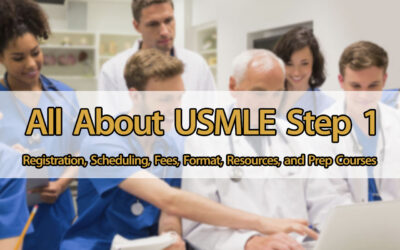Failing the USMLE Step 1 test can be a setback, but it doesn’t mean your medical career is over. Around 3,000 test-takers don’t pass each year, but 72% of those from the U.S. who fail the first time get a residency. If you fail, the first thing you should do is let your medical school know so you can talk about retaking the test and figure out a plan to do better.
It’s essential to take a moment to process what happened, remembering that this failure isn’t about you as a person, and it doesn’t have to last forever. Having the support of your friends or family can help you get through this rough time.
After that, you should think about why you didn’t pass. It could be because you could have managed your time better, needed to know more, or were too anxious during the test. Once you figure out the problem, you can change how you study to fix it. You should also consider getting help from a mental health professional or a USMLE prep program. This could be a chance for you to learn and grow.
Ensure you’re up to date on any USMLE Step 1 test changes. And remember, you’re not the only one who’s gone through this, and you can always retake the test.
Table of Contents
Understanding USMLE Step 1
The journey toward becoming a licensed medical practitioner in the United States is multifaceted, and the USMLE Step 1 plays a pivotal role in this odyssey. Often hailed as the foundation stone, this exam encapsulates the essence of what budding doctors have assimilated in the early years of their medical education. Beyond the mere rote learning of facts, the USMLE Step 1 challenges candidates to interlink their foundational science knowledge with real-world clinical scenarios, laying the groundwork for a successful medical career.
The United States Medical Licensing Examination (USMLE) Step 1 is a standardized test that assesses a medical student’s knowledge of basic science concepts and their application to clinical medicine. The exam is one of three components required for medical licensure in the United States and is typically taken by students after their second year of medical school. The USMLE Step 1 consists of 280 multiple-choice questions administered over eight hours. The exam covers anatomy, biochemistry, pharmacology, and physiology.
This rigorous examination evaluates not only the academic prowess of medical students but also their ability to think critically and apply knowledge in high-pressure scenarios. The USMLE Step 1 remains an indispensable metric in the medical licensure process with its vast syllabus and comprehensive assessment pattern. It ensures that only the most capable and knowledgeable candidates pave their way toward serving the community as licensed medical professionals.
What If I fail step 1? Consequences of Failing the USMLE Step 1
Failing the United States Medical Licensing Examination (USMLE) Step 1, a rigorous exam designed to assess a medical student’s understanding of basic science concepts and their application to clinical medicine can be a significant setback. Still, it’s not the end of the road. Many students who initially fail Step 1 pass it on their subsequent attempts.
When students fail Step 1, they are usually allowed to retake the exam, though the specific retake policies can vary by medical school. Some institutions may require students to take a leave of absence to prepare for the exam, while others may allow them to continue their studies concurrently. These strategies, coupled with a rigorous review of the material and taking practice tests, can help students increase their chances of success in their next attempt.
However, it’s important to note that a failing score on Step 1 can impact a student’s medical career trajectory. Residency programs often look at Step 1 scores when considering applicants, and a failing score could potentially limit a student’s options. Nevertheless, perseverance, hard work, and a focus on understanding and addressing areas of weakness can help students overcome this initial hurdle and continue on their path to becoming doctors.
You’re in trusted hands with our proven track record of assisting thousands in acing the exam with our USMLE Step 1 prep course confidently and efficiently. Dive into our Step 1 prep course today and make your success inevitable. Remember: while a setback in the USMLE Step 1 is challenging, it’s not the end. Armed with the right approach, your path to becoming a leading medical professional is well within reach.
Strategies for Overcoming a Step 1 Failure
As a medical student, facing a Step 1 failure can be discouraging, but it’s essential to remember that it doesn’t signal the end of your medical career. There are several strategies you can use to overcome this challenge.
Acknowledging the Setback
The path to becoming a medical professional has its challenges, and facing setbacks like failing the USMLE Step 1 can be challenging. However, remember that many accomplished doctors have faced similar hurdles. Instead of getting overwhelmed, use this setback as a catalyst for introspection and growth.
Every obstacle provides a lesson for future success. It’s vital to identify where things went wrong, seek mentorship, and adopt effective strategies for your next attempt. This setback is a minor chapter in the broader context of your career. With dedication and the right mindset, you can bounce back stronger and continue on your journey to medical excellence.
Evaluating Study Habits
When prepping for the USMLE Step 1, it’s super important to look at how you’ve been studying. This test has many things, like anatomy, biochemistry, pharmacology, and physiology. Knowing where you rock and where you might need some extra work helps if you’re thinking about retaking the test. One cool idea? Talk to people who know their stuff. Maybe it’s a mentor, a friend from class, or even someone who’s taken the test before. They might see things differently and point out things you didn’t consider. Mixing what you know about yourself with tips from others will give you a better game plan for next time.
Creating a New Study Plan
As you return to studying and recognize where you went wrong, your next move is to make a better study plan. Now that you know what needs more focus, you should create a plan that tackles those tough topics. Don’t be scared to try new things – change how you study, try different ways of learning, or look at further study materials. Active learning, like explaining stuff to a friend or using memory tricks, can help. Even though you might want to study constantly, it’s important to pace yourself. Mix in breaks with your study time. These breaks are super important, whether just chilling or doing something fun. They help you relax and come back feeling fresh and ready to study some more.
Practicing Self-Care
Getting ready for a big test like the USMLE Step 1 can be challenging, and if you’re too stressed, it can mess up your score. That’s why, along with hitting the books, you must ensure you’re feeling good in both your body and mind. Make sure you move around, eat right, and get enough shut-eye. These things can help you study better and do well on the test. Meditation or taking a few deep breaths can chill you out when things get too intense. Remember, staying calm and looking after yourself will make a massive difference in how you do it.
Utilizing Available Resources
Always remember you’ve got a whole team behind you! There’s much help, from your teachers and buddies in class to the folks at the school’s help center. Plus, there are loads of online forums, study groups, and prep materials for students like you. And remember workshops or tutoring sessions your school might offer. Dive into these resources; they can provide fresh perspectives or study techniques you have yet to try. Everyone faces challenges, but when you tap into the wealth of support available, you’re setting yourself up for success. So, take a deep breath, gather your resources, and remember, it’s all about using what’s around you and not being afraid to ask.
Understanding the Scoring System Changes
If you’re gearing up for the USMLE Step 1, you must be in the loop about the changes they introduced in 2022. Instead of assigning a numerical score, the exam follows a more straightforward pass/fail system. The idea behind this shift was to move away from just chasing numbers and instead focus on actual learning and personal growth. This new approach alleviates some of the immense pressure candidates often feel. However, as with most changes, it has stirred varied reactions within the medical community. Some see it as a positive step towards a more holistic evaluation, while others might be skeptical. As an aspiring medical professional, keeping informed about these changes and discussing them with experienced peers can give you a broader perspective on approaching your preparation.
Resilience in the Face of Setbacks
A lot of top doctors have had bumps in the road. But it’s not about the hard times you hit; it’s about how you handle them. Stay strong and keep your eyes on the prize. Remember, you aim to be a great doctor who cares about your patients. So, avoid getting too hung up on mistakes or challenges. Instead, learn from them and move forward with even more determination. Everyone has rough patches, but they can teach you much if you let them. Embrace each experience, both good and bad, as a stepping stone toward your dream. Surround yourself with supportive peers and mentors who can guide you. After all, setbacks are just setups for comebacks in your journey to medical success.
Additional Note
Based on our collective experience as professors, we’ve observed and mentored numerous students on their medical journeys. A consistent piece of advice we underscore is the significance of diving deep into study resources, exploring varied exam techniques, and finding personalized approaches to handle stress. Remember, each individual’s learning journey is distinct, and an effective method for one might not resonate with another. Especially with the recent transition of the Step 1 exam to a pass/fail system, it’s paramount to understand its potential impact on residency applications. Being thorough and well-informed now can shape your future in medicine.
Historical background of USMLE Step 1
The transformation didn’t stop there. As the medical field advanced, the test’s nature adapted. From its earlier iterations that focused primarily on basic sciences, the USMLE Step 1 began to pivot, reflecting a more clinically-applied understanding of foundational sciences. This progression culminated in adoption of a computer-based format, making the examination more accessible and streamlined.
Moreover, in a significant update in May 2015, the USMLE integrated a renewed emphasis on patient safety and quality improvement. This was not isolated just to Step 1 but permeated the entirety of the USMLE exam series. This shift underscored the exam’s commitment to aligning with modern medical practices, ensuring that aspiring medical professionals are well-equipped to meet the evolving patient care demands.
The Shift to Pass/Fail Scoring
However, there’s another side to this coin. Initially, the Step 1 test was designed to measure a student’s knowledge of foundational sciences. Over time, its score became a significant factor in residency selections. This put immense pressure on students, pushing them to sometimes prioritize the test over other vital parts of their education.
The shift to a pass/fail system aims to challenge this mindset, but concerns exist. With the score no longer being a clear differentiator, would other aspects of a student’s profile now become overly emphasized? For instance, would letters of recommendation now bear too much weight? Or would universities begin to rely heavily on subjective evaluations?
The heart of the issue lies in finding a balanced way to evaluate a budding doctor’s potential. The USMLE Step 1 is just one piece of a much larger puzzle, and the medical community must ensure that they are looking at the entire picture, not just one corner of it.
Format of USMLE Step 1
What’s unique about this test is its setup for each person. While every student gets a mix of questions from different topics, only some people’s combination is identical. Your friend might feel they had more questions from, let’s say, pharmacology, while you might get more on anatomy. This individualized approach ensures a broad evaluation of knowledge across subjects.
Over the years, as medicine and education practices evolve, the content and focus of these questions have been updated. The goal always remains: ensuring that upcoming doctors have a solid understanding of the core sciences. With the rise of technology and advancements in medical research, it’s essential that the test remains relevant and continues to align with the changing landscape of medical practice.
Scoring of USMLE Step 1: Transition from Number-Based to Pass-Fail
Delving deeper into its history, the scoring metrics of the exam have seen other evolutions. Until 1999, it was all about percentiles, showing you where you stood among your peers. However, the turn of the millennium saw the introduction of a more uniform three-digit scoring system, offering clarity and consistency. And while a two-digit counterpart once existed, it was phased out by 2013 in favor of simplicity.
There’s reassuring news for those who’ve walked the USMLE journey before 2022. The scores you’ve achieved, represented in the trusted three-digit format, will remain intact on your USMLE transcripts. No revisions, no retroactive changes. In this evolving world of medical education, the integrity of past achievements is respected and upheld.
Current Trends in USMLE Step 1
Historically, students were encouraged to tackle the USMLE Step 1 right after delving deep into foundational sciences before embarking on core clinical clerkships. This sequence, while time-honored, often presented its challenges. However, in recent years, the winds of change have blown through the corridors of medical schools. Many of these institutions are now advocating for an enriched learning experience. They’re restructuring their curricula, allowing students to immerse themselves in core clinical clerkships or preliminary clinical training before taking the USMLE Step 1. This revamped approach ensures that when students sit for the exam, they are armed with theoretical knowledge and practical insights gleaned from real-world clinical exposures.
Such progressive changes resonate with the broader objective of producing doctors and holistic healthcare practitioners equipped to navigate the complexities of modern medicine. As the medical community continues to evolve, it’s clear that the USMLE Step 1 is more than just an exam; it’s a testament to adaptability, resilience, and the undying spirit of medical excellence.
Future of USMLE Step 1: What Lies Ahead?
The main idea behind going pass/fail was to lessen students’ stress and put a bigger spotlight on actual learning and self-betterment. It’s a clear sign that the focus is on creating a more balanced testing environment for students. As we look ahead, any new shifts or updates to the exam will likely follow in this student-centric direction, ensuring that the main aim is always to prepare the next generation of doctors in the best possible way.
Furthermore, as the medical field constantly evolves, the content and structure of exams like the USMLE Step 1 will inevitably have to adjust in response. Stakeholders, including students, educators, and medical professionals, will be vital in providing feedback to ensure the exam remains relevant and valuable. The overarching goal will always be to provide a comprehensive evaluation while prioritizing the well-being and development of medical students.




